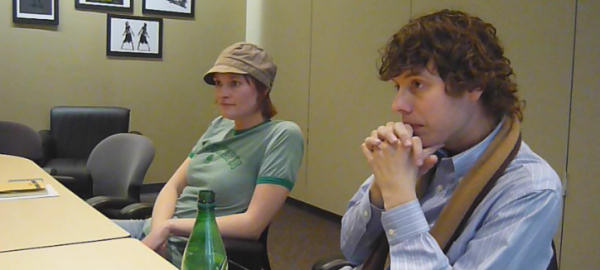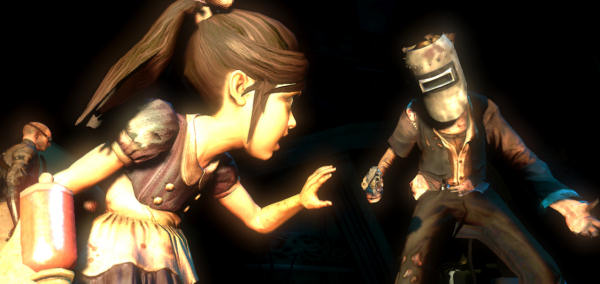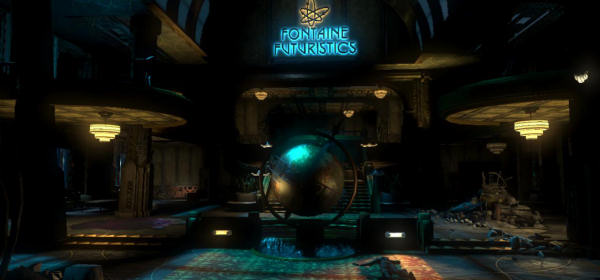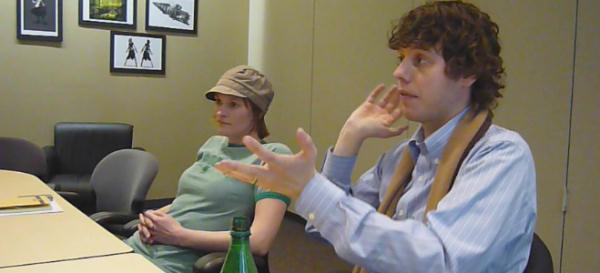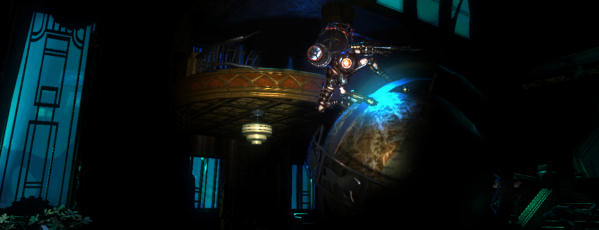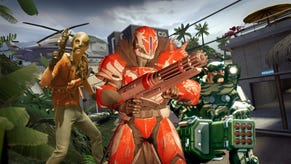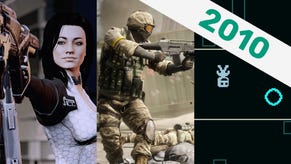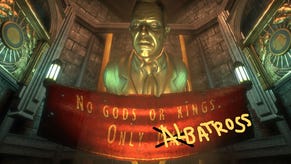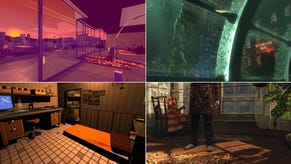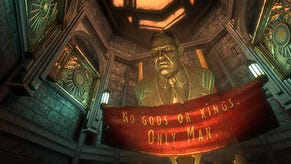RPS BioShock 2 Interview
Making a rare guest appearance on Rock, Paper, Shotgun, Eurogamer's Editor bossman Tom "Tom Bramwell" Bramwell was recently visiting 2K Marin, the developers behind BioShock 2, and interviewed lead environment designer Hogarth De La Plante and senior producer Melissa Miller to find out some more details about what we can expect from the enormously anticipated sequel. They discuss the role the ocean is going to play in the game, how Rapture has changed in the ten years since the original game, why defence is going to play as big a part as offence this time, and what it's going to be like to be a Big Daddy.
Tom: How do you go about decaying Rapture by ten years?
Hogarth De La Plante: Well, very specifically, interior locations in BioShock 2 are going to be a lot more mouldy and flooded, falling down and ramshackle. There are some other things that we’re doing environmentally that we can’t really talk about right now. But in getting to go out into the ocean you’ll get to see parts of Rapture that are completely destroyed, and so really understand that the ocean is trying to reclaim the city, and in some cases has completely reclaimed what were once interiors.
Tom: How much of the world outside Rapture do you explore and see? And how do you handle that, as opposed to the interior corridor stuff?
HD: It’s not a bathysphere simulator. We’re using it in a pretty controlled way. In some instances going out into the ocean is a necessary navigational bypass – you can’t get through somewhere, so you find an airlock and go outside and around. In other cases you can optionally enter the ocean. The ocean really functions for a couple of reasons on a mechanical level. The first is narratively it gives you some quiet time for us to have people talk to you on the radio, and for you to pick up logs. Also, there’s loot scattered outside in the ocean, the detritus of the city is out there. It’s a contemplative area when you’re not receiving narrative. We think it works metaphorically very well. Water has always been a symbol of consciousness in literature, and subtitle of the game is Sea of Dreams. We think it works on a very moody, metaphorical level.
Tom: Will there be limitations to how long you can spend outside in the ocean?
HD: It’s like Zack, our lead designer says, “You don’t have a fun meter”, you know, there’s no air gage. You can dick around out there. The way we think about the ocean in terms of level construction – when you exit an airlock you’re in a gigantic room – you can’t wander off for thirty miles into the sea. They are constrained environments, but they’ve very textural, there’s things to walk up and down, things to look inside, places to explore while you’re outside. You’ll never go into a section of the ocean where there’s five things coming off of it. Usually you’re in the water and there’s probably one place you’re trying to get to.
Tom: How much of Rapture is basically switched off now?
HD: There are damaged sections that are damaged beyond repair, but there’s an equilibrium that’s been reached in Rapture at this point. It’s been ten years, but there’s still Splicers down there who have been splicing and evolving. They’re living in a static way, there’s a successful ecology that’s happening in Rapture right now.
Tom: So obviously much of the first game is fondly remembered. Will we get to go back anywhere?
HD: You’ll see locations from the first game. You’ll see Arcadia, but you’re not going to go back there. You can see the Kashmir Restaurant through the window. We want to acknowledge some of those areas existed, as Easter eggs if nothing else.
Melissa Miller: Regarding the history of Rapture, a lot was established in the first game. But that’s not it. In BioShock 2 we’re really excited to be showing more of that history.
Tom: To what extent do you have an effect on the environment now you’re a Big Daddy?
HD: Your relationship as a player to your environment in a BioShock title is a systemic one, so when you see a puddle of oil you know you can set that on fire. When you see a splintered, broken down door, you know you can break your way through. There are certain Big Daddy accessible things that we are working in to the environment of BioShock 2. That’s something that formed the core vocabulary of exploring our spaces, like if you see a frozen door you know you can unfreeze it. And more combinatory things, we’re trying to expand the plasmid combination stuff that you can do. That’s something that people have a lot of creativity with in the first game.
MM: We have to make sure that when you see things in the world, they do what you expect. Now you have the drill and the rivet gun, we need to produce that same process for BioShock 2. To make sure your effect on the world is believable and satisfying.
HD: Be cool if there were some new plasmids.
MM: Mmmmm.
HD: Mmmmm.
Tom: It would be seriously uncool if there weren’t.
MM: Noted. “Uncool.”
Tom: After the DLC content for BioShock [for the PS3 version only – some Challenge Rooms that required more imaginative use of the game’s tools], are you keen to encourage people to go further with experimentation angle?
MM: One of the things I’m most excited about is the whole adoption mechanic. In Bio 1 we had the roaming boss battles, and those were opportunities for you to play with the tools. The beauty of BioShock is you didn’t have to go too deeply into the plasmid set if you didn’t want to. But yeah, the Challenge Rooms were exactly that. An opportunity to say, “Hey, look! If you play with it, look what it can do!” So one of the things I really like about the adoption is that it’s like the inverse of the roaming boss battles, because instead of choosing your time to attack, you’re choosing your time to defend.
HD: “I’m a boss. Come get me, Splicers!”
MM: Just that change means that you’re going to be paying a lot more attention to the toolset that’s all about defence, setting those perimeter traps and so on. Because some people really went for that, but other people didn’t.
HD: One thing I remember talking to Jordan about, about a year ago when we were brainstorming things, was, “You know Jordan, the systemic stuff in BioShock is super-interesting, and I felt like the combat was so frenetic in the first game that there were very few moments when you could set down a considered attack, or a considered defence scenario.” And so we decided back then that we wanted to encourage that more in some areas of the game.
MM: But it’s always the player’s choice.
Tom: Has it been difficult to balance the player’s abilities? You were pretty powerful by the end of the first game.
HD: I think we realised that in some ways at the end of BioShock 1 was a little bit too easy for some players, and that’s something we’ve talked about for a year.
MM: Now we have even more to consider, because now you’re a Big Daddy. Now you’re supposed to be powerful. But making sure that we’re still offering challenges to the player. We’re definitely going to be paying a lot of attention to making sure that feels good and challenging.
Tom: We’ve seen the new clips of the water bursting through the walls. Will there be a lot more of that sort of thing?
HD: It’s tricky because you have to balance the wow moments, which are usually scripted events. People love that stuff, but that stuff is also contrary to the game - you’re supposed to make choices and do whatever you want. So we have to balance that stuff. Those things a lot of the time are directly related to some piece of training in the narrative, like the first time you inject a plasmid in BioShock 1. Yeah, we sort of make that happen without your control, because there is something very important we’re trying to show you at that point. I wouldn’t say we’re doing that stuff any more or less than in the first game. We’re very careful about when those things happen though.
Tom: We’ve not seen much about what weapons and elements will be returning from the first game. Can you tell us any more about those?
MM: We’re trying to sell being a Big Daddy as the core fantasy for the game. So obviously a Big Daddy holding a pistol that he could crush? That’s not going to fulfil the fantasy. So, we want to make you feel powerful, so the weapons need to do that in a Big Daddy’s hand. We can talk about the drill and the rivet gun, which are both super-cool, because hey, how many times did you want to pick up the rivet gun in the first game?!
Huge thanks to Tom for his moonlighting moment, and to Melissa and Hogarth for their fantastic answers. Don't forget to check out our BioShock 2 impressions.


